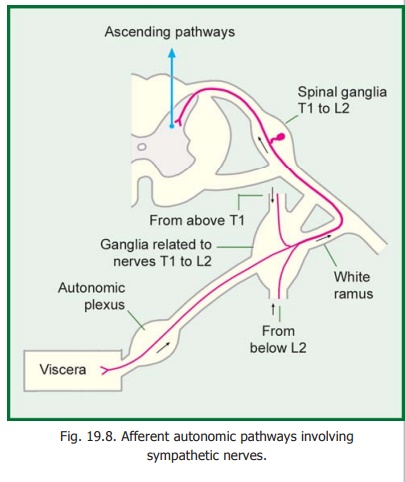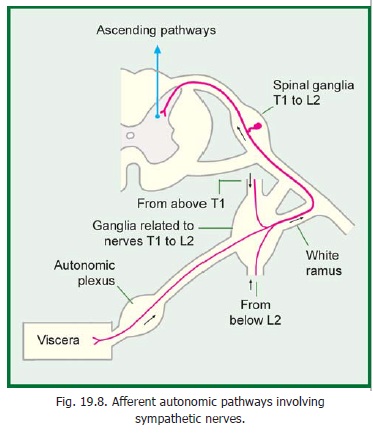Chapter: Human Neuroanatomy(Fundamental and Clinical): Autonomic Nervous System
Afferent autonomic pathways

AFFERENT AUTONOMIC PATHWAYS
We have noted that sensory neurons related to the autonomic nervous system are general visceral afferent neurons; and that their arrangement is similar to that of afferent fibres in cerebrospinal nerves. The neurons concerned are located in spinal ganglia, or in sensory ganglia of cranial nerves. They carry impulses arising in viscera, and in blood vessels, to the central nervous system. They may be associated with the parasympathetic as well as the sympathetic systems. Accordingly, the cell bodies of the neurons in question may be located in one of the following situations.
Afferents Related to the Cranial part of the Parasympathetic System
These are general visceral afferent fibres related to the glossopharyngeal and vagus nerves. The cell bodies of the neurons concerned are located in sensory ganglia related to the cranial nerve in question. Their central processes terminate in the nucleus of the solitary tract. Some fibres may terminate in the dorsal vagal nucleus. The most important general visceral afferent fibres are those carried by the vagus nerve. Sensory fibres carried by the vagus innervate all organs to which its efferent fibres are distributed. The sensory fibres in the vagus are much more numerous than efferent fibres. Apart from carrying sensations afferent fibres are involved in various reflexes related to the organs concerned.
Glossopharyngeal afferents carry sensations from the pharynx and from the posterior part of the tongue. They also innervate the carotid sinus and the carotid body.
Afferents related to the Sacral part of the Parasympathetic System
These afferents are peripheral processes of unipolar neurons located in the dorsal nerve root ganglia of the second, third and fourth sacral nerves (Fig. 19.7B). These fibres run through the pelvic splanchnic nerves to innervate pelvic viscera. The central processes of these neurons enterthe spinal cord. The spinal pathways carrying afferent impulses from the viscera are not fully established.

Afferents related to the Sympathetic Nervous System
Afferent fibres accompany almost all efferent sympathetic fibres. These afferent fibres are peripheral processes of unipolar neurons located in the spinal ganglia of spinal nerves T1 to L2 (or L3) (Fig. 19.8).

Some Further Comments on Autonomic Afferents
Some important points that may be noted about autonomic afferents are as follows.
a. Autonomic afferents are necessary for various visceral reflexes. Most of these impulses are not consciously perceived.
b. Some normal visceral sensations that reach consciousness include those of hunger, nausea, distension of the urinary bladder or rectum, and sexual sensations. Sense of touch or pressure perceived by the tongue and pharynx, and the sensation of taste are also visceral sensations.
c. Under pathological conditions visceral pain is perceived. This is produced by distension, by spasm of smooth muscle, or by anoxia.
d. Sensory impulses from the same organ may travel both along sympathetic and parasympathetic nerves .
Related Topics